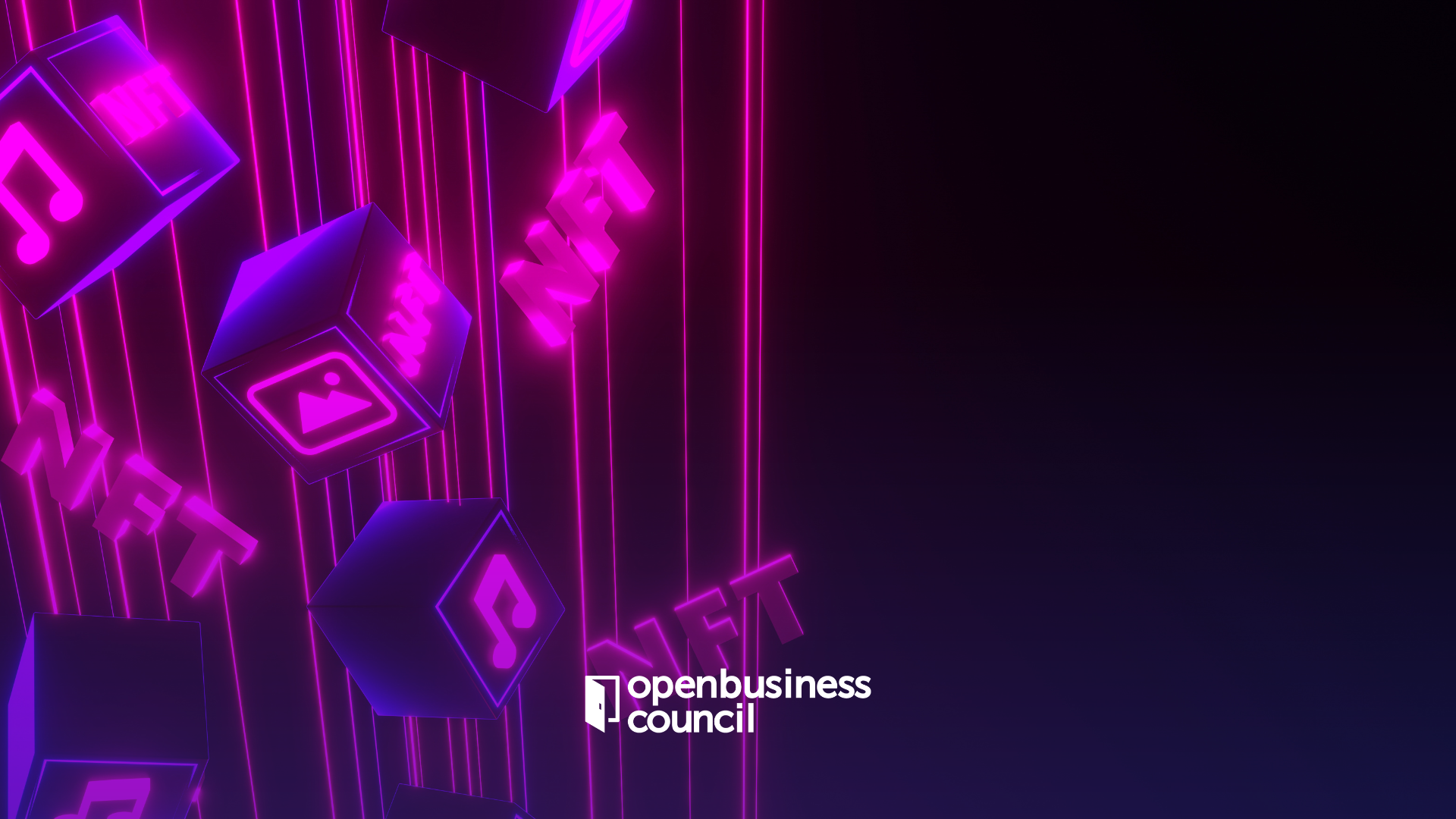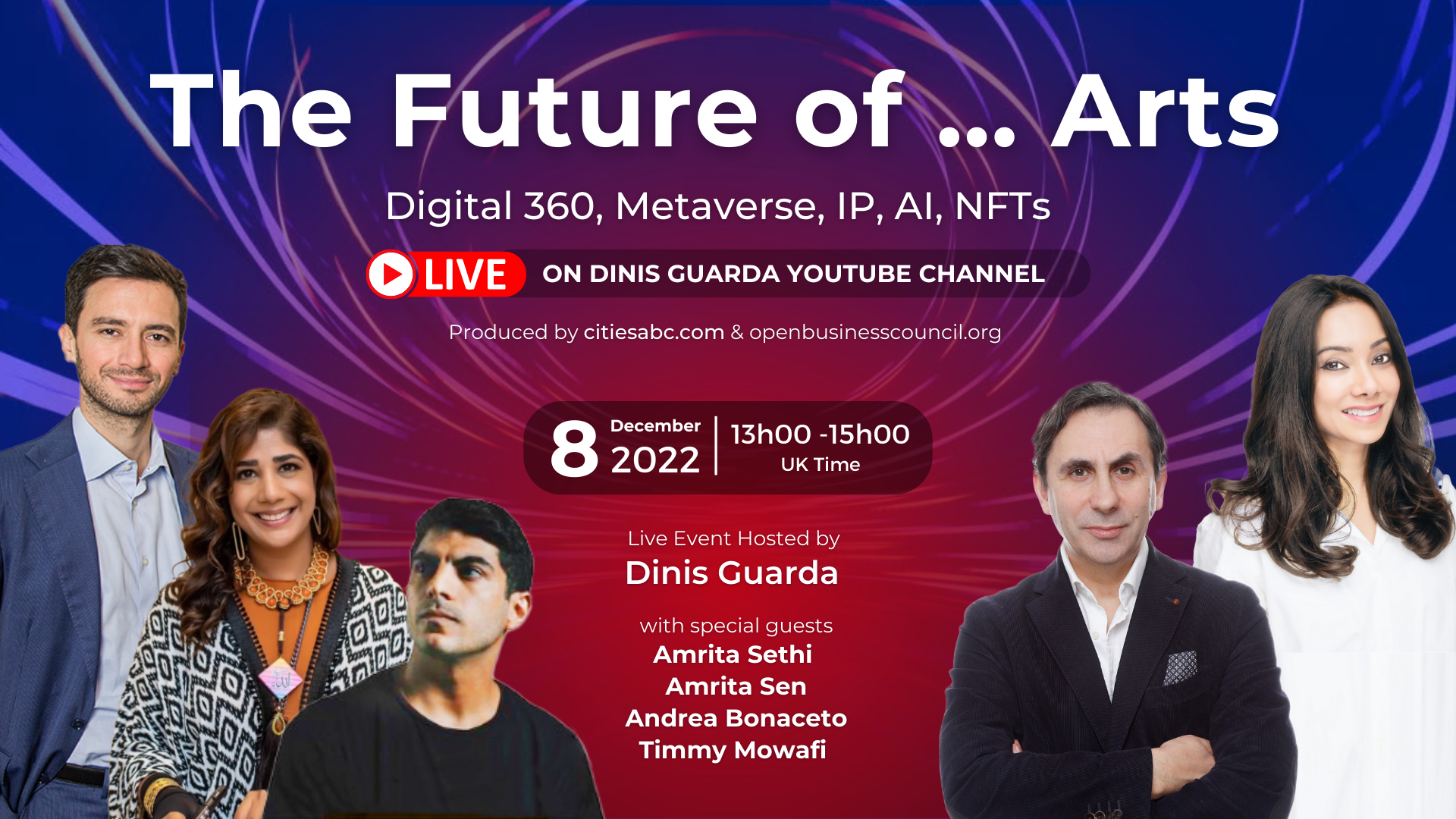A few years ago, the thought that a digital artwork could be worth the same as a sketch by Rembrandt would have been unbelievable. The Internet was a place where we could copy and paste ad infinitum, hence making ownership and authenticity hard to track down (and to enforce). How many masterpieces have been shared widely without reputational or financial credit to the artist? How many digital masterpieces have been seen by only a handful of people? Now, Blockchain and NFTs are here to fix a long-time issue since the internet started.

This article is in collaboration with the online event ‘‘The Future of… Arts: Digital 360, NFTs, Metaverse, IP, AI." Live on Dinis Guarda YouTube Channel on December 8 from 1 pm to 3 pm GMT.
In theory, existing frameworks and mechanisms such as copyright law provide artists with the protection they need, and the Internet offers the broadest possible market. However, copyright provides little practical protection for most artists in such a fast-paced and ephemeral environment. The Internet can be too general and too exposed a context to showcase art.
This is changing.
NFTs have transformed the way we view and consume art via the Internet. It has also created a paradigm shift for artists. Where the instant and free reproduction of ‘copy and paste’ was a barrier to monetisation, NFTs have paved a solid path to compensation.
“Investing in the art world is unique because art is something you can barely measure in currency. The same investor concept has been transferred to digital artworks, and many of these artworks have been sold for hundreds of thousands or even millions,” says Joel F. Kuck, CEO of Famous Token, an NFT platform created for famous artists with their own gallery in the Vegas Arts Village on Decentraland.
Authenticity and Uniqueness
The emergence and adoption of NFTs respond to two critical challenges associated with digital artworks: authenticity and uniqueness. NFTs go a long way to address these issues and provide a means to turn digital artworks into close-to-real-world assets.
NFTs provide an enduring means of certifying the authenticity of a particular work and remove the possibility of unauthorised access to and replication. An NFT can encapsulate and encrypt the original and other information related to it, including terms of ownership, use, and access.
These properties protect each work's uniqueness and provenance and benefit the artist who can monetise their artwork more easily whilst preventing piracy.
Uniqueness and Scarcity
Beyond creative genius, uniqueness and scarcity are significant drivers of the monetary value of fine art. These aspects are fundamentally undermined by the infinitely duplicable quality of digital media. However, NFTs create scarcity where there was none because they allow owners to claim ownership of an intangible digital asset and control who gets to access the complete picture, i.e., high-resolution image and any context provided by the artist.
Auction sales for NFT artworks have become astronomic, with millions spent on individual NFTs. The art industry alone has done over $150m in sales volume, with individual artists selling art as NFTs for 6-7 figures.
Sales data shows just how powerfully NFTs have impacted the art industry. According to Chainanalysis, In 2021, almost $41 billion worth of Ethereum-based NFTs were sold.
According to the latest Art Basel and UBS Art Market report:
“Global sales of art and antiques reached an estimated $50.1 billion, down 22% from 2019. Online sales of art and antiques reached a record high of $12.4 billion, doubling in value on the previous year and accounting for a record share of 25% of the market’s value.”
2020 marked the first time the share of e-commerce in the art market has exceeded that of general retail, and the digital collectables market reached $400 million in March 2021, almost doubling the total sales in 2020.
But mirroring the proverbial volatility of this sector, from April 15, 2021, to May 15, 2022, the total value of sales involving non-fungible tokens (NFTs) in the art sector fluctuated significantly. As of May 15, 2022, the aggregated number of sales recorded on the Ethereum, Ronin, and Flow blockchains over 30 days was 20.6 thousand.
Creators & Creative Freedom
NFTs benefit creators by protecting their ownership and enabling the monetisation of their work. NFTs encapsulate ownership rights, and their smart contract nature codifies the rules for being rewarded in return for selling or licensing these rights.
NFTs not only certify who owns the digital asset, but they also specify and enact the automatic fulfilment of the related conditions of the contract. Smart contracts ensure the creator’s share is paid with greater surety than would ever exist in a physical transaction.
Financially NFTs have had a huge and beneficial impact on creators as the NFTs are generally designed to ensure that they are paid a percentage of the sales proceeds every time their work is sold. This approach means that the creator shares in and benefits from the value of their work in perpetuity, not just at the point of the first sale, heralding an end to the days when artists remain in poverty while their work is resold for vast sums.
The advantages of NFTs are registering across the creative community: Canadian singer Grimes sold $6 worth of digital art; Nyan Cat, a 2011 YouTube video and Internet meme, was remastered by original creator Chris Torres and sold as a digital asset for 300 ether ($587,000) in 2021; art collective Moments in Time sold a triptych of supermodel Kate Moss, the proceeds of which went to mental health charity Gurls Talk.
NFTs are certainly attracting more creatives. Artist, writer and art dealer Kenny Schachter explains his interest in NFTs:
“All the art I make is digital, in the form of videos or images — now I’m chomping at the bit to sell more works this way. I am convinced that the field will mushroom in the coming two or three years.”
Schacter offered a series of digital artworks on the NFT platform Nifty Gateway in 2021 titled ‘That’s All Folks’ (a reimagining of Looney Tunes end titles featuring Donald Trump in the wake of the former President’s departure from the White House) in an edition of five for $500 each. While this may seem a modest price compared to the lofty sums raised by Chris Torres for Nyan Cat, Schachter obtained a commission each time his art is resold, which means his earnings grow with his work’s value as determined by collectors.
In 2021 famous visual artists Charlotte Taylor and Nicholas Préaud created an NFT artwork based on an OMA (a renowned international architectural firm) designed sculpture.
The installation was part of an underwater park near Miami Beach. The proceeds from the NFT sale were used to help promote the ReefLine sculpture park.
OMA told the online magazine Dezeen that:
"The NFT is meant to depict the unique nature of the ReefLine sculpture," "The sculpture is a piece of resilient infrastructure as much as it is a formal object. The form will encourage coral reef growth, creating a new aquatic ecosystem that helps to protect the coastline."
NFTs allow the market to determine the value of work outside of the influence of institutions that have traditionally had a massive say in what may or may not be of value. Especially as the sale of most NFTs is by auction, which is not true of much physical art, at least not the first time round. Riding the NFT wave are prominent auction houses like Christie’s and Sotheby’s.
In 2022, over 3.1 million artworks had been sold in the CryptoArt market as of May 2022, and the total CryptoArt market was capitalised at $2 billion.
NFTs have, in a short time, tapped into our desire to acquire and own, creating value and a whole new dimension of investment commodities. NFTs can be used to encapsulate and represent the ownership of almost anything, which makes for a vast potential market. Art is just one of the markets.
---

What the future looks like for artists, collectors and businesses? That’s the quesction that the speakers from the upcoming event ‘The Future of… Arts: Digital 360, NFTs, Metaverse, IP, AI’, hosted by Dinis Guarda, will try to answer. A one-only live event taking place on December 8 (1pm to 3pm GMT) on Dinis Guarda YouTube Channel, renowned speakers Amrita Sen, artist, designer, and business Woman; Amrita Sethi, NFT Artist; Timmy Mowafi, entrepreneur, creative Director and co-Founder of MO4 Network; and Andrea Bonaceto, contemporary artist and NFT pioneer will come together to shed light on the Future of Arts.